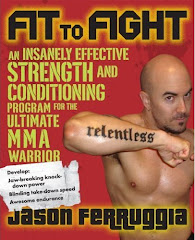
With summer rapidly approaching I know that many of you are in a big rush to get ripped in a hurry. The problem is that, more often than not, people take on this goal with a completely flawed approach. The result is that they end up small, weak and flabby. Or, worse yet, they don't even try to get lean because they have seen one person after another start a fat loss phase only to end up... small, weak and flabby.
The good news is that this doesn't have to happen. My friend and colleague, John Alvino has the solution to this problem and recently I got him to share his secrets with us. John is a training advisor for Men's Fitness magazine and one of the most experienced and knowledgeable experts in the fitness industry today.
When I asked John, yesterday, about how to lose fat without sacrificing any muscular size or strength, here is what he had to say...
************************
Most fat loss programs leave you with less muscle, less strength and less energy. This unfortunate fate may be acceptable to a competitive bodybuilder, who can afford to sacrifice a couple pounds of his muscle and has absolutely no concern for his strength or power. This unique exception notwithstanding, I can’t imagine anyone being willing to sacrifice their hard-earned muscle and long-term metabolic rate, just to shed a few pounds of fat.
I have been an athlete all my life, and a strength and conditioning specialist for over 16 years now. Over the years, I have discovered some amazing techniques that allow my clients to get ripped while simultaneously INCREASING their strength and power. Even people who tend to lose muscle very quickly on a normal fat loss protocol will find that with my system, they will not lose one precious pound of the muscle they bled to build.
See, the majority of the guys I train for fat loss are not just trying to get lean so they can prance around on a stage while wearing a Speedo. To the contrary, most of my clients are high level athletes who want to get lean in order to improve their performance. It’s no secret that if an athlete is carrying around an extra 15-20 pounds of body fat, he will not run, jump or move as well as he would without that unnecessary body fat slowing him down.
On the other hand, it is imperative that these guys improve upon all of their physical qualities, such as strength, power, speed and agility. Thus, they must steer clear of any protocol that has a negative impact on any of these qualities. The challenge is to get as lean as possible, while building (or at least maintaining) muscle mass, and continuing to make strength gains. That’s where I come in to play.
I have developed a very unique fat loss system that employs many clever training and nutritional tricks and techniques. I basically “fool” the body into holding on to its lean muscle for dear life, while at the same time tricking it into burning its own fat for fuel as quickly as possible. The results have been tremendous.
Here are a few brief points that one should consider when entering a fat loss phase.
1) Don’t decrease calories by more than 15% below your maintenance levels. This is one of the keys to maintaining all of your muscle mass during a fat loss phase. If you have a time constraint (weigh in for sport, wet t-shirt contest, etc), you may have to decrease your calories further than 15%. In these rare cases, you can decrease calories as low as 25% below maintenance, but be sure to temporarily increase your calories at regular intervals. This brings up our next point.
2) Do not stay in a caloric deficit for longer than 5 consecutive days. Staying in a caloric deficit for too long leads to a slower metabolism, less glycogen (stored carbohydrates in your muscles that are crucial for athletic performance), and without fail, losses in lean muscle mass. This is easily avoided by “eating up” occasionally to replenish your glycogen stores and give your metabolic rate a much needed boost.
3) Focus on force output during your cardio workouts. Many so-called fat loss “experts” love to say, “You shouldn’t output a lot of force during cardio. You will fatigue and have to stop before you burn enough calories.” These critics are missing the forest for the trees. There are 2 critical points that they are completely disregarding.
First, they are focusing solely on the amount of fat loss that occurs during the cardio workout itself. This is foolish, because if a cardio program is designed correctly, the majority of the fat loss from that cardio will occur AFTER the workout has already been completed. As a matter of fact, it turns out that the post-workout energy expenditure that follows a very intense cardio workout burns much more fat than a long, boring low intensity cardio session ever could.
Second, they are neglecting the fact that low intensity cardio actually encourages the fast twitch muscle fibers to take on characteristics of slower twitch fibers (for those of you who don’t know, it is your fast twitch fibers that provide you with explosive strength and quickness). These are very serious consequences to a high level athlete.
For both of these reasons, I strongly advise you to stay far away from low intensity cardio. So what kind of cardio should you perform? That brings up my next point.
4) It’s no secret that a great way to integrate higher intensity cardio into your routine is high intensity interval training (HIIT). The problem is that there is so much confusion about how to perform HIIT properly, and what work to rest ratios provide maximal results.
I have discovered after years of methodical research that there is no perfect ratio across the board. However, it turns out that each specific type of HIIT exercise does actually have its own optimal work to active rest ratio.
For example, some well respected experts have asserted that the best work to rest ratio is 1 to 3. This is true for a few specific exercises, but for many other important and popular forms of exercise, it is completely wrong.
Let’s take the jumping rope, for example. Can you imagine getting a great workout from jumping rope for 1 minute, and then resting for 3 full minutes? As you can see, a “one size fits all” approach is seriously flawed when it comes to HIIT training. So knowing the exact ratios that best accompany the different forms of exercise is of paramount importance. I have spent years calculating them quite precisely, and when you hit the right combination on the button, the results are incredible.
5) Resistance training is of the utmost importance in any fat loss protocol. However, there are just as many misconceptions about how to properly weight train for fat lass as there are about performing cardio for fat loss. In particular, be very careful not to use a “high rep” approach exclusively. This is very popular among some well known fat loss gurus, and it is the kiss of death for anyone who truly wants permanent and sustainable fat loss. Using high reps exclusively can actually cause you to lose muscle mass during a fat loss phase. This will with direct negative impact on your metabolism, thus making it that much harder for you to lose your next pound of fat. Even further, this type of resistance training will cause you to lose strength and power, for the exact same reasons that low intensity cardio does.
A resistance training program is crucial to fat loss, but it must be designed very shrewdly. A specific balance between higher rep exercises and lower rep exercises must be utilized if optimal results are to be seen.
Start employing these tips right away, and you will see immediate and dramatic improvements in your strength, energy, and fat loss results. Good luck!
-------------------------------
John is having a very special introductory sale on his long awaited Complete Fat Loss system. This is not something that was slapped together overnight. On the contrary, John worked on this for over a year. I should know because he called me up more times than I care to remember at midnight or later to get my opinion on a new chapter or some other aspect of the product. I have never seen so much work put into a fat loss system before and believe it is the most comprehensive system on the market today.
Check it out by clicking HERE.
Jason Ferruggia
Performance Enhancement Specialist
Chief Training Adviser, Men's Fitness Magazine







